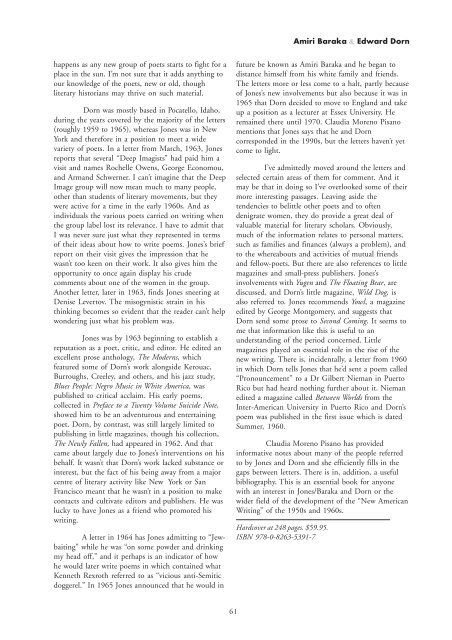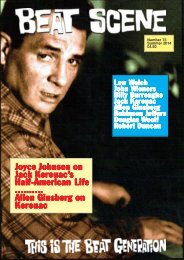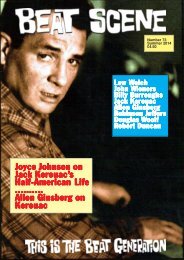You also want an ePaper? Increase the reach of your titles
YUMPU automatically turns print PDFs into web optimized ePapers that Google loves.
Amiri Baraka & Edward Dorn<br />
happens as any new group of poets starts to fight for a<br />
place in the sun. I’m not sure that it adds anything to<br />
our knowledge of the poets, new or old, though<br />
literary historians may thrive on such material.<br />
Dorn was mostly based in Pocatello, Idaho,<br />
during the years covered by the majority of the letters<br />
(roughly 1959 to 1965), whereas Jones was in New<br />
York and therefore in a position to meet a wide<br />
variety of poets. In a letter from March, 1963, Jones<br />
reports that several “Deep Imagists” had paid him a<br />
visit and names Rochelle Owens, George Economou,<br />
and Armand Schwerner. I can’t imagine that the Deep<br />
Image group will now mean much to many people,<br />
other than students of literary movements, but they<br />
were active for a time in the early 1960s. And as<br />
individuals the various poets carried on writing when<br />
the group label lost its relevance. I have to admit that<br />
I was never sure just what they represented in terms<br />
of their ideas about how to write poems. Jones’s brief<br />
report on their visit gives the impression that he<br />
wasn’t too keen on their work. It also gives him the<br />
opportunity to once again display his crude<br />
comments about one of the women in the group.<br />
Another letter, later in 1963, finds Jones sneering at<br />
Denise Levertov. The misogynistic strain in his<br />
thinking becomes so evident that the reader can’t help<br />
wondering just what his problem was.<br />
Jones was by 1963 beginning to establish a<br />
reputation as a poet, critic, and editor. He edited an<br />
excellent prose anthology, The Moderns, which<br />
featured some of Dorn’s work alongside Kerouac,<br />
Burroughs, Creeley, and others, and his jazz study,<br />
Blues People: Negro Music in White America, was<br />
published to critical acclaim. His early poems,<br />
collected in Preface to a Twenty Volume Suicide Note,<br />
showed him to be an adventurous and entertaining<br />
poet. Dorn, by contrast, was still largely limited to<br />
publishing in little magazines, though his collection,<br />
The Newly Fallen, had appeared in 1962. And that<br />
came about largely due to Jones’s interventions on his<br />
behalf. It wasn’t that Dorn’s work lacked substance or<br />
interest, but the fact of his being away from a major<br />
centre of literary activity like New York or San<br />
Francisco meant that he wasn’t in a position to make<br />
contacts and cultivate editors and publishers. He was<br />
lucky to have Jones as a friend who promoted his<br />
writing.<br />
A letter in 1964 has Jones admitting to “Jewbaiting”<br />
while he was “on some powder and drinking<br />
my head off,” and it perhaps is an indicator of how<br />
he would later write poems in which contained what<br />
Kenneth Rexroth referred to as “vicious anti-Semitic<br />
doggerel.” In 1965 Jones announced that he would in<br />
future be known as Amiri Baraka and he began to<br />
distance himself from his white family and friends.<br />
The letters more or less come to a halt, partly because<br />
of Jones’s new involvements but also because it was in<br />
1965 that Dorn decided to move to England and take<br />
up a position as a lecturer at Essex University. He<br />
remained there until 1970. Claudia Moreno Pisano<br />
mentions that Jones says that he and Dorn<br />
corresponded in the 1990s, but the letters haven’t yet<br />
come to light.<br />
I’ve admittedly moved around the letters and<br />
selected certain areas of them for comment. And it<br />
may be that in doing so I’ve overlooked some of their<br />
more interesting passages. Leaving aside the<br />
tendencies to belittle other poets and to often<br />
denigrate women, they do provide a great deal of<br />
valuable material for literary scholars. Obviously,<br />
much of the information relates to personal matters,<br />
such as families and finances (always a problem), and<br />
to the whereabouts and activities of mutual friends<br />
and fellow-poets. But there are also references to little<br />
magazines and small-press publishers. Jones’s<br />
involvements with Yugen and The Floating Bear, are<br />
discussed, and Dorn’s little magazine, Wild Dog, is<br />
also referred to. Jones recommends Yowl, a magazine<br />
edited by George Montgomery, and suggests that<br />
Dorn send some prose to Second Coming. It seems to<br />
me that information like this is useful to an<br />
understanding of the period concerned. Little<br />
magazines played an essential role in the rise of the<br />
new writing. There is, incidentally, a letter from 1960<br />
in which Dorn tells Jones that he’d sent a poem called<br />
“Pronouncement” to a Dr Gilbert Nieman in Puerto<br />
Rico but had heard nothing further about it. Nieman<br />
edited a magazine called Between Worlds from the<br />
Inter-American University in Puerto Rico and Dorn’s<br />
poem was published in the first issue which is dated<br />
Summer, 1960.<br />
Claudia Moreno Pisano has provided<br />
informative notes about many of the people referred<br />
to by Jones and Dorn and she efficiently fills in the<br />
gaps between letters. There is in, addition, a useful<br />
bibliography. This is an essential book for anyone<br />
with an interest in Jones/Baraka and Dorn or the<br />
wider field of the development of the “New American<br />
Writing” of the 1950s and 1960s.<br />
Hardcover at 248 pages. $59.95.<br />
ISBN 978-0-8263-5391-7<br />
61





